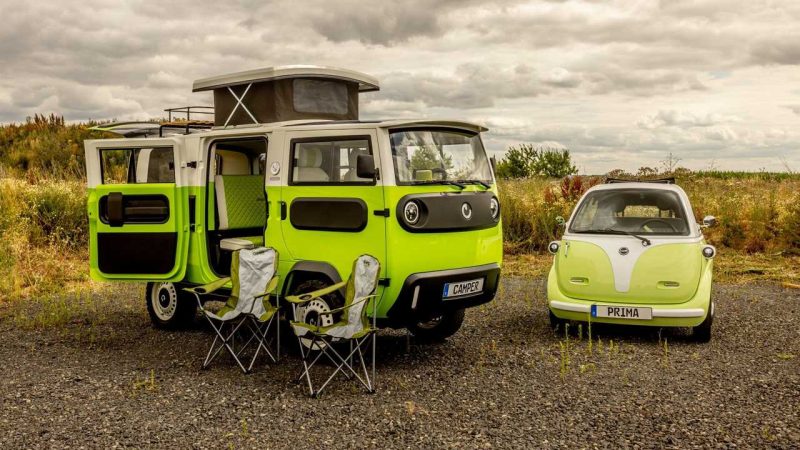On July 7, 2020, a prototype of the XBUS, an electric camper van, was unveiled in Europe. ElectricBrands showed the prototype at roadshows in Germany, Italy, and France. After getting feedback, the company unveiled a second prototype in early November 2020. It’s not yet in production, but the company is taking pre-orders in dozens of European countries.
Let’s take a closer look at the XBUS prototype!
What Is the XBUS RV?
The XBUS is a four-wheel drive vehicle with electric motors. It measures about 13 feet long, about 5 ½ feet wide, and about 6 ½ feet high. The dry weight of the XBUS ranges from 1,100 to 1,760 pounds, and the GVWR is about 3,500 pounds.
Available in two different chassis options, owners can opt for the standard chassis or off-road chassis, which starts at about $2,200 more than the standard. The off-road chassis provides more ground clearance and comes with off-road tires and a modified body.
There are also numerous module options from which to choose. The Base features a flatbed and a two-door cab. The Pickup has higher walls than the base to create a truck bed shape for easy loading and unloading.
If you’d like to upgrade the pickup, you can choose the Tipper module that includes a tilt in the loading area. The Pickup Bus adds a rear cab behind the driver’s cab, providing more seating space and shortening the truck bed.
The Camper module looks like a bus with no truck bed. It features a two-person sleeping area and a space-saving kitchen with a sink, refrigerator, and hotplate. If you want the truck bed back, you can choose the Cabrio module, which has the driver’s cab, rear cab, and small truck bed like the pickup bus but also features an option to open the roof in both cabs.
The Box module, the largest of the XBUS options, looks like a box truck with a load volume of over 211 cubic feet. The Bus module looks like a Volkswagen bus and provides enough space for luggage and a few friends. Finally, the Transporter is the “all-rounder” and looks similar to the Bus module. It’s the most expensive of the XBUS options.

What Is the Range of the XBUS?
All modules come standard with a 15 kWh battery. This provides up to 124 miles of range. Owners who want to increase the range can opt for a 45 kWh battery, giving them up to 372 miles of range. You need to fully charge the XBUS in 3 to 6 hours, depending on the battery.
Who Makes the XBUS?
Focused on leaving a smaller footprint, ElectricBrands is building the XBUS with natural fibers, composites, aluminum, steel, wood, and recyclable plastics to achieve more than 95% recyclability.
In addition, the solar roof is standard, and the aim is for a charging performance of approximately 600 watts. There are hundreds of dealers throughout Europe who will carry the XBUS. In Austria alone, there are more than 20.
HOT TIP
Find out how Strange-Looking Electric Vehicles Could Make Great Campers.
Will XBUS Be Sold in the US?
Currently, the XBUS is only available in Europe. There are 31 countries where you can pre-order, including Austria, Belgium, Denmark, Finland, France, Germany, Poland, Romania, Spain, and the United Kingdom.
In the online configurator “light,” prospective owners can configure their XBUS with the most important equipment features. Owners get a production number and are charged a reservation fee of 10% of the expected net purchase price (plus the legally applicable VAT in Germany).
Since the XBUS isn’t in production yet, prospective owners will receive a link approximately three months before the start of production to make the final configurations and order their XBUS. There are options for cash payment, financing, and leasing.
If you go ahead and receive a production number, pay the reservation fee, and then change your mind, you can completely reconfigure your XBUS during the final configuration. You can even cancel your pre-order. If you do cancel, you’ll get the reservation fee back – minus the processing fee of $159.

How Much Does the XBUS Cost?
Like all types of RVs, the XBUS modules vary in pricing depending on the layout, amenities, and features. The cheapest XBUS module is the Base and starts around $18,400 plus the statutory VAT for the specific country.
The Camper module is the most expensive, starting at around $31,500 plus the VAT. The upgrade to the off-road chassis will increase the starting price of all modules.
HOT TIP
Uncover all you need to know about Airstream’s electric travel trailer.
What Other Electric Campers Are Being Developed?
In the United States, there are a couple of electric RVs in development. In 2021, Winnebago unveiled a working model called the E-RV produced by their Advanced Technology Group.
While still only a concept, it’s made with sustainable materials like recycled cork-rubber flooring and has a charging time of 45 minutes at high-current charging stations. The Ford Transit platform has been modified with an advanced electrical power system from Lightning eMotors and hopes to have a range of around 125 miles.
Thor Industries also released a concept electric RV called the Vision Vehicle. This camper van can charge in about 75 minutes and has an increased range of 300 miles. Like Winnebago, Thor is intentionally creating a sustainable, eco-friendly product made from recycled paper, bamboo, cork, and thin-cut slate.
The couch also contains recycled foam within the cushions. There has also been interest in Tesla’s Semi and Cybertruck vehicles. Perhaps they will one day pull a camper or be used in motorhomes.
Is an Electric Camper the Wave of the Future?
The German Iridium EV by WOF debuted in 2019 and seems to be one of the only available electric RVs on the market in the world. The motorhome can go 249 miles on a 108Kwh battery pack and includes a dry bathroom, kitchen, split double bed, and dining lounge. But other companies are seeking to make electric campers the wave of the future.
ElectricBrands is actively configuring, designing, and tweaking the XBUS to be the next big release of electric campers in Europe. Winnebago and Thor have joined the movement in the United States. Hopefully, we’ll soon see these ERVs available worldwide for purchase and delivery.
Would you consider purchasing an XBUS or other type of electric camper?
If You Love RVing, You Need to Stay Informed
Don’t rely on biased RV industry news sources to keep you informed with RVing news.
Stick with Nomadic News. We publish daily articles and breaking stories that matter to your RV lifestyle.










